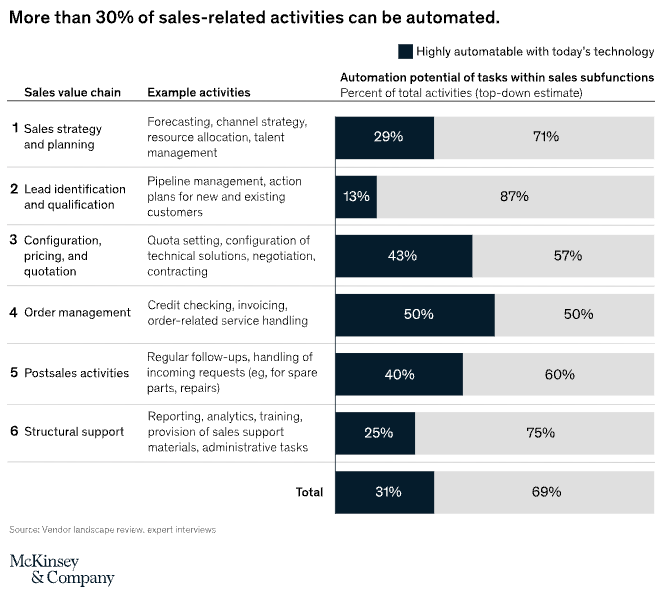You’ve learned the ins and outs of Revenue Operations (RevOps) and how it plays a vital role in synchronizing sales, marketing, and customer success efforts to supercharge revenue. You’re familiar with what makes a powerful and robust RevOps tech stack. And you have the know-how to assemble a top-notch RevOps team. But here’s a game-changer you might not be aware of: low-code automation is the secret weapon for a winning RevOps strategy.
We’re at a pivotal moment: businesses are working to meet their customers’ ever-evolving expectations for swift, personalized purchasing experiences, but must do so in an agile, competitive, and efficient way in the face of unpredictable market conditions.
In short, thriving in today’s landscape hinges on achieving reliable and efficient revenue generation. That’s why so many companies are investing in RevOps – and why the Head of RevOps is the fastest-growing job in the US.
But to truly get the most out of RevOps, businesses must prioritize efficiency, connectivity, and flexibility – and that’s where low-code automation comes in. End-to-end automation of core RevOps processes such as lead lifecycle management, order-to-cash, and customer onboarding can have an incredible impact on the customer experience, leading to higher retention rates and attainable upsell/cross-sell opportunities.
Low-code automation: Unlocking the full potential of RevOps efficiency
Low-code automation platforms empower business users by simplifying complex tasks, providing a versatile and robust platform for integrating applications and automating processes without the need for extensive API knowledge or coding expertise. RevOps teams, responsible for managing numerous processes across many different applications, can harness the power of low-code automation to eliminate manual tasks, break down departmental and application silos, and expedite revenue-generating processes.
By implementing a low-code automation platform into their overall RevOps strategy, RevOps teams can achieve:
Enhanced efficiency: RevOps teams must often grapple with an inordinate amount of manual tasks such as CRM data entry, contract reviews, and billing and invoicing. With low-code automation, RevOps teams can easily automate these processes, letting them focus on more strategic initiatives and customer engagement.
Error reduction: RevOps professionals are definitely the superheroes of your organization. But they’re still only human. Automation lowers the likelihood of human error, ensuring consistency and accuracy throughout the RevOps process.
Accelerated time-to-value: Modern low-code automation platforms offer businesses the scalability to adapt to customer demands and market conditions swiftly. Reusable workflows, plug-and-play templates, and self-guided learning paths let RevOps teams quickly ramp up their automation initiatives and easily adapt to changing needs.
Flexibility: Low-code platforms offer extensive customization options, enabling teams to fine-tune their workflows and applications to tackle specific challenges and seize opportunities.
Low-code automation RevOps use cases
Low-code automation can revolutionize various aspects of the RevOps process. Let's explore some specific use cases:
Lead Lifecycle Management
Eliminate manual lead list uploads: 78% of prospects buy from the first company to respond to their inquiry. So when you’ve got a list of leads to upload into your CRM, timeliness is everything and real revenue is on the line. With 80 unique templates, low-code automation platforms like Tray offer the flexibility to accurately capture leads from virtually any source including Excel, LinkedIn, and Google Sheets, and record them in your CRM and Marketing Automation Platforms (MAPs), despite each lead’s unique, source-created properties.
Automatically enrich leads for clean, reliable data: Your contact database decays anywhere from 20 – 25% every year. People who have engaged with your company may change jobs, the company may move, and so on. Not having fully formed lead data hinders your sales team's ability to follow up, causing friction along the entire lead lifecycle. Low-code automation platforms let RevOps teams build powerful automated lead enrichment processes resulting in better lead data and faster follow-up.
Route high-quality leads to sales faster: In our recent survey of RevOps professionals, 80% report a clear desire to route leads—from inbound capture to sales—in one day or less. However, inefficiencies in the lead lifecycle management process prevent almost a third of companies (31%) from achieving this goal. With low-code automation, RevOps teams can seamlessly connect their tech stack and automatically capture, enrich, and route leads to sales teams as soon as they come in.
Order-to-Cash
Simplifying the sales order process: Research from McKinsey suggests that reducing complexity in the sales process can increase revenue by up to 25%. Low-code automation enables the creation of streamlined sales order workflows, automating tasks such as quote generation, order entry, and approvals, ensuring a smooth order-to-cash process.
Automating invoicing and payment collection: Low-code platforms can be used to develop customized invoicing and payment collection workflows, automating tasks such as invoice generation, reminders, and reconciliation, thus reducing the likelihood of errors and late payments.

According to McKinsey & Company, more than 30% of sales-related activities can be automated.
Customer Onboarding
Customizing onboarding workflows for different customer segments: Customers today want two things from their buying process: speed and personalization. In fact, 58% of customers say that personalized experiences are crucial when interacting with a company. Low-code automation allows teams to create tailored onboarding workflows for different customer segments, ensuring a quick, consistent, and personalized experience.
Ensuring a consistent onboarding experience: For RevOps teams, the key to delivering fast and personalized customer experience is consistency. With low-code automation platforms, RevOps teams can automate every step of the onboarding process, such as account creation, product configuration, and training, guaranteeing a consistent experience for all customers.
Upselling/Cross-selling Motions
Identifying upsell/cross-sell opportunities: The probability of selling to a new prospect is 5 – 20%. The probability of selling to an existing customer is 60–70%. With low-code automation platforms, RevOps teams can automate onboarding, send personalized notifications and reminders for upcoming renewals or negotiations, and provide insights into product usage and support tickets, letting businesses increase customer retention, cross-sell, and upsell more effectively.
Automating the contract renewals process: Here’s another interesting tidbit: 80% of your future profits will come from 20% of your existing customers. Low code automation platforms let RevOps teams simplify the contract renewal process by visually connecting renewals data across their CRM, ERP, contract management, payables, marketing, chat apps, and even analytics tools for complete automation and full visibility.
Choosing the right low-code automation platform for RevOps
Not all low-code automation platforms are created equal. When evaluating low-code automation platforms to support your RevOps initiatives, consider the following key features:
Complex workflow orchestration: RevOps processes are complex. Lead lifecycle management involves lead intake, lead enrichment, lead routing, and so on. Order-to-cash involves creating sales orders, invoicing, applying payments, and more. These processes require more than connecting and automating processes between two applications.
Modern low-code automation platforms are specifically designed for intricate workflow orchestration across multiple applications, databases, and services. They offer advanced business logic capabilities such as control loops, branching, nesting, and data manipulation, allowing RevOps teams to visualize and execute their ideal processes without compromises.
Flexible integration capabilities: 54% of RevOps professionals say they spend too much time building and maintaining integrations. Limitations in connectivity to specialized applications or databases lead to time-consuming workarounds or fragmented integrations across multiple platforms. While pre-built connectors are common, they may not cover all the required operations RevOps teams need, resulting in a “connector wall” that hinges connectivity to essential functionalities in your CRM, MAP, or ERP.
Look for modern low-code automation platforms that can connect to any REST, SOAP, or GraphQL API on demand, ensuring no API or operation is out of reach. Additionally, modern platforms provide a low-code visual builder for easily creating custom connectors.
Scalability: RevOps teams are the backbone of your business, overseeing some of the most crucial business processes. The last thing you want is for one of these processes to fail because your automation platform couldn’t efficiently scale to meet demand changes. With entry-level and legacy platforms, increased API volume and frequent workflow triggers can lead to rate limits, resulting in missed opportunities or errors.
Modern low-code automation platforms run on a serverless architecture, enabling the efficient handling of large data volumes. With elastic, serverless architecture, you can trust your workflows to run smoothly and effectively solve business problems without facing scaling difficulties.
Collaboration and reusability: Since RevOps involves people and processes across Marketing Ops, Sales Ops, and Customer Success, your automation platform needs to facilitate collaboration. Look for platforms that offer collaborative features such as workspaces, projects, and role-based access controls, ensuring there are no conflicts when multiple people are building integrations and workflows.
Reusability is also key for ensuring efficiency. Modern platforms allow for the reuse of integrations and business logic across teams, reducing duplicative efforts, and maintenance. For RevOps, this is particularly valuable when building complex processes like lead lifecycle management, where components such as lead import, routing, and enrichments can be reused.
Tray for RevOps teams
Low-code automation has the potential to transform the way businesses approach RevOps, driving efficiency and enabling the delivery of a seamless customer experience. By embracing low-code automation, organizations can unlock the full potential of their RevOps strategy, reaping the benefits of increased revenue, higher customer retention rates, and improved sales win rates. It's time to consider low-code automation as the key to unlocking RevOps success and giving your customers the experience they expect and deserve.
To learn more about how Tray can be your RevOps’ secret weapon, watch a quick demo.




